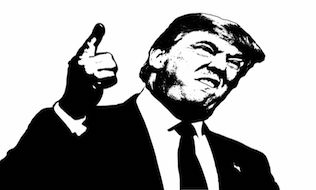

A recent report from the C.D. Howe Institute suggests that in addition to levying a bevy of tariffs on some of America’s biggest trading partners, U.S. President Donald Trump is using the uncertainty he’s creating in order to gain further leverage at the global negotiating table.
“Under the Trump administration, U.S. trade policy has been characterized by implausible claims, demands and threats, which are then retracted, then reasserted and so on,” the report noted.
As other countries struggle to respond, institutional investors are navigating an increasingly murky investment environment as Trump carries on with what the report called “outlandish, unworkable proposals to manipulate trade flows that appear deeply uninformed.”
Whether it’s antagonizing Mexico, Canada, China or the European Union, it’s hard to tell how much of it is a negotiating tactic from the U.S. administration, versus an attempt to address an actual economic issue, says David Lafferty, senior vice-president and chief market strategist at Natixis Investment Managers.
Read: Investors challenged by ups and downs of NAFTA talks
When it comes to China, the United States has more of a legitimate grievance on intellectual property rights, he says. “In a sense, China isn’t playing by the rules of the game. If you fast-forward that to NAFTA, it isn’t that Mexico and Canada aren’t playing by the rules; it’s just that the president doesn’t like the rules.”
Regardless, it’s hard to tell where the president’s overall motivation is actually coming from, says Lafferty. In playing to his midwestern agricultural and manufacturing bases of support, Trump evidently hopes to appear tough on trade, he says, even as his actions challenge the core Republican tenant of favouring the free movement of goods.
“[Trump’s] clearly been front and centre in terms of the rhetoric, but it’s unclear if that’s because he believes this is truly an issue or because he believes that it somehow improves his long-term bargaining position as he tries to get more concessions,” says Lafferty.
For long-term investors, the uncertainty could put downward pressure on the synchronized global growth the world has seen in past years, he says, particularly when it comes to supply chains. Businesses now have to operate in a confusing environment because of Trump’s lack of predictability and policy coherence, according to Lafferty. “This is not some type of cliff edge where this happens all of a sudden and every business all of a sudden reduces capital investment or starts firing people. But if people operate in a long enough period of uncertainty, this will begin to become a larger drag on the global economy. I don’t think we’re there just yet, but that lack of predictability is a long-term problem.”
Read: What does U.S.-North Korea summit mean for Asia’s investment environment?
Whether markets are hurting from the rhetoric is another story, he notes. While they’re still rising, public equity markets have been a lot more volatile during the trade hostilities, he says. “While I don’t think this should be fundamentally changing our asset allocation views, our core views on stocks or bonds, there is an argument that this could eventually weigh on growth more significantly. And I’m not worried about inflation, I’m not worried about prices necessarily. I’m much more worried about supply chains.”
U.S. trade partners are retaliating heavily. Chinese imports of soybeans are shifting to Brazil from the United States, as a 25 per cent tariff takes effect July 6, Bloomberg reported. Chinese demand could easily outstrip what Brazil can export, forcing China to find other sources, possibly even returning to the United States, according to Bloomberg.
Trump’s 20 per cent tariff on Canadian softwood lumber has sharply increased the price of building materials, according to the National Association of Home Builders. The U.S. organization noted the rise in the price of lumber has resulted in added costs of $9,000 for a single-family home and $3,000 for multi-family dwellings.
Read: Top 40 Money Managers: Charting the course through choppy waters
Meanwhile, the European Union has slapped tariffs on a plethora of U.S. exports, including bourbon, orange juice, several varieties of rice and motorcycles. Harley-Davidson Inc. has drawn Trump’s ire after it announced on Monday that it would be moving some production of its motorcycles from the United States in order to mitigate price increases for European consumers, which it noted in a regulatory filing would otherwise rise by US$2,200 on average per vehicle.
Global supply chains for vehicles such as cars are extremely complex, says Lafferty. Those sorts of industries, as well as sectors like oil and natural gas, are likely to be some of the most sensitive to the ongoing trade disputes, he says. Indeed, the Canadian automotive sector is bracing for impact, with Trump already having put steel and aluminum tariffs in place and threatening further levies on completed vehicles.
As the United States heads for midterm elections in November, Trump will be balancing his trade moves with often-conflicting signals from his base and the capital markets, Lori Heinel, deputy global chief investment officer of State Street Global Advisors, pointed out in a recent blog post. ”The question is whether he can adequately calibrate reaction to those conflicting signals or if the tit-for-tat spirals out of control,” she said.
Read: Currency considerations as plan sponsors grapple with volatility
